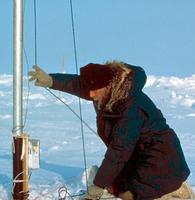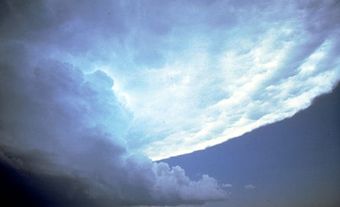
Climate Information
The climate system consists of the LAND, the OCEANS, the atmosphere, the biosphere (VEGETATION) and the cryosphere (ICE and SNOW). Information on all these components is necessary to describe and understand the Earth's CLIMATE. To measure near-surface conditions over land, most countries, including Canada, operate climate-observing networks that measure quantities such as temperature, humidity, precipitation, WIND and sunshine. Observations of the atmosphere are taken regularly using radiosondes, aircraft and SATELLITES in support of WEATHER FORECASTING, and these data are also used for climate studies. Although observations of the oceans and SEA ICE are not taken regularly, data from specific research projects can be used to provide climate information, and some near-surface data are regularly available from ships and satellites. Data on vegetation types and land use form the bulk of the information on the biosphere.Climate information is used by a variety of people. Building designers must be certain that their structures will withstand the strongest winds and be habitable during temperature extremes. Airlines, when possible, plan their routes to take advantage of the prevailing winds in the upper atmosphere. Agricultural workers need to know whether precipitation and temperature levels will permit the cultivation of certain CROPS. Climatologists and other researchers also require information to attempt to understand the behaviour of the climate system.
How Climate Information Is Produced
Climate information is produced by processing the enormous amount of data obtained over a fairly long period of time by various observing networks. Current computer-based data storage and processing methods greatly facilitate this task. The most familiar types of climate information are the so-called "30-year" normals, which provide information primarily on near-surface conditions over land. This type of data is produced by most countries in the world. Thirty-year normals are constructed by processing data from over the past 30 years to describe average conditions and extremes over that period. Every 10 years, the 30-year normals are recalculated using only the most recent 30 years of data.
Other forms of climate information, such as the global distribution of wind and temperature throughout the atmosphere, sea-ice conditions and POLLUTION, are readily available. The information is disseminated by most countries in serial publications. Many national weather services are also able to provide more comprehensive climate information in digital form. Specialized climate information is available in research reports and in scientific journals. An increasing amount of basic climate information, as well as inventories of national climate data holdings, is available on the INTERNET.
Beginnings of Records
Reliable climate information has been available only since the development of weather instruments. The development of the thermometer and barometer mark the beginning of the instrumental record, but these records were kept only at a few locations worldwide. Regular measurement of near-surface conditions over large areas of the globe did not begin until the 19th century. Regular sampling of the upper atmosphere over large geographic areas did not begin until after WWII. Even with the use of instruments, there are large parts of the world, especially over the southern oceans, where few data are available. Since satellites are able to cover the entire globe, they are used to provide reliable remotely sensed data in regions where no direct observations are available (see REMOTE SENSING).
Information on climate conditions that existed before the instrumental record is severely restricted. Proxy data from sources such as tree rings, ice cores and sediment cores are used to reconstruct past climates.
There is also increasing need to have information on future climates. CLIMATE CHANGE can result naturally, not only from events like VOLCANOES and FOREST FIRES, but also from the chaotic inherent variability of the climate system itself. Climate change can also result from anthropogenic causes, such as an augmentation of the greenhouse effect resulting from the burning of fossil fuels. Ongoing research is attempting to understand climate change with a view to predicting and gathering information on future climates in order to minimize the adverse effects of climate change on human activities.
See also CLIMATE AND SOCIETY; CLIMATOLOGY; WEATHER OBSERVATIONS; CLIMATE AND MAN; CLIMATE SEVERITY.

 Share on Facebook
Share on Facebook Share on X
Share on X Share by Email
Share by Email Share on Google Classroom
Share on Google Classroom


